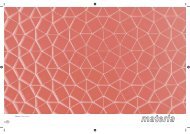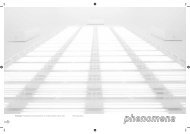Media - ross mcleod
Media - ross mcleod
Media - ross mcleod
You also want an ePaper? Increase the reach of your titles
YUMPU automatically turns print PDFs into web optimized ePapers that Google loves.
100<br />
Materiamatics<br />
Michael Trudgeon<br />
Memory Screen Michael Trudgeon and David Poulton<br />
‘The best way to predict the future is to invent it.’ 1<br />
Societies need to plan for the future in order to survive. Those that have not have<br />
perished. One is either made subservient by the future or part of its planning and<br />
making. The following comments on materials are made in this light.<br />
Ezio Manzini, the Italian architect and writer, tells us that in the age of plastic,<br />
material certainty has vanished. 2 Wood is not wood (it might be dust and glue),<br />
stone is not stone (it might be glass and polyurethane). Materials are now what we<br />
choose to make them. In the plastic age the designer is faced with designing the<br />
materials as much as the objects, the space or the building constructed from the<br />
material. The material’s performance, thermal properties, opacity and electrical<br />
conductivity, and now informational conductivity are all designable, malleable and<br />
changeable. You get to choose. While much of this research was originally restricted<br />
to the car industry and military research, the effects are now widely apparent.<br />
Given this fluid set of options the materials we select or design can truly reflect our<br />
intent. They are no longer guides or boundaries but vectors or agents of the design.<br />
Following this assertion it could be claimed that the world of materials has two<br />
sides, one an immanent (indwelling, inherent, permanently pervading the universe,<br />
from the Latin manere, to remain), the other side, transcendent: materials in the<br />
service of ideas. This second one sees the skin as both the starting point for the<br />
experience and the possible communication of ideas (as the structure is either<br />
incidental or just expedient) and of the greatest significance.<br />
The immanent is the world of structure and material presence; the other is a<br />
world of signs, vectors and shape shifters, a world of information. Modernism<br />
has been proposed as a kind of nude architecture or design, preoccupied with<br />
the structural notions of materials and its simple meaning, divested of any<br />
polychromatic membrane it might have had thrown over its body. My interest<br />
lies in that membrane.




